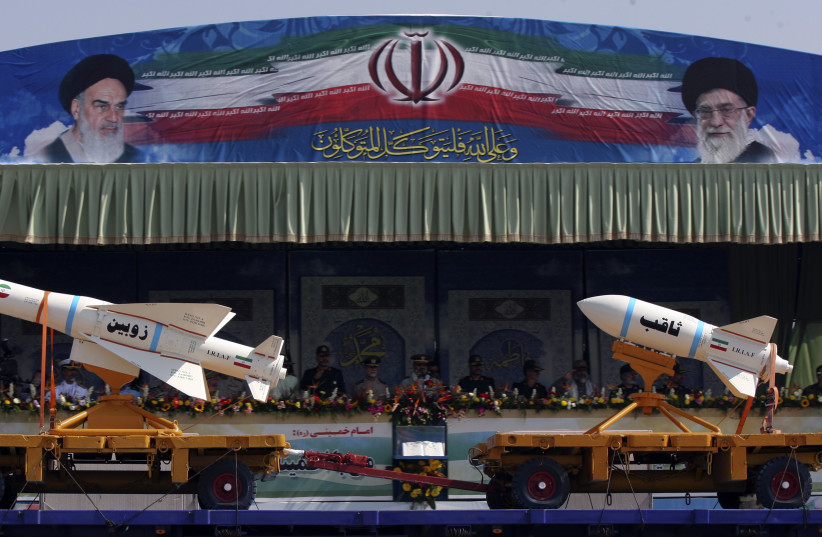Theoretically, it may be possible for Iran to develop a nuclear device or perform a full nuclear test using the uranium it has enriched to 60% that it will have accumulated by April 21, Institute for Science and International Security President David Albright has written in a report.
Albright’s supposition is somewhat theoretical because discussion about nuclear weapons developed from uranium in recent decades has focused on the 90% enrichment level.
That level has so far been the focus of Israel, the US and other parties seeking to prevent the Islamic Republic from developing a nuclear device.
And even if Tehran reaches the 90% level, Israeli intelligence and nuclear experts have said that Iran would need another six months to two years to perfect methods for detonation, warhead miniaturization, missile reentry and other issues to be able to deliver such a weapon.
Still, a report by Albright and Sarah Burkhard said that, “as soon as mid-to-late April, Iran is expected to reach a new, dangerous, destabilizing threshold, having enough highly enriched uranium (HEU) to fashion a nuclear explosive, about 40-42 kilograms of 60% enriched uranium (uranium mass).

“With this quantity, an enrichment level of 60% suffices to create a relatively compact nuclear explosive; further enrichment to 80 or 90 percent is not needed,” said the report, contradicting what the media generally reports on the matter.
“According to the International Atomic Energy Agency, 41.7 kg of 60%-enriched uranium (uranium mass) is a significant quantity, which the IAEA defines as the ‘approximate amount of nuclear material for which the possibility of manufacturing a nuclear explosive cannot be excluded,’” wrote Albright.
“A common fallacy is that Iran would require 90% HEU, more commonly called weapons-grade uranium, to build nuclear explosives,” he claimed.
“Although Iran’s nuclear weapons designs have focused on 90% HEU and likely prefer that enrichment, modifying them for 60% HEU would be straightforward and well within Iran’s capabilities.”
He further stated that, “historically, the term ‘highly enriched uranium’ was developed in the nuclear weapon states to distinguish between enriched uranium able to fuel a practical nuclear weapon versus enriched uranium, labeled low enriched uranium, unable to do so. Their cutoff is at 20% enriched uranium.”
In fact, Albright explained to The Jerusalem Post that lower levels of enriched uranium were used in nuclear weapons designs by the US in the 1940s as well as by South Africa.
“LITTLE BOY,” the nuclear bomb dropped on Hiroshima mixed the highest level of enriched uranium with some uranium enriched to as low as 50%.
Albright said that states have focused on the 90% level because its more compact size makes it usable on missiles, while lower enriched nuclear weapons are larger and much harder to deliver.
Also, he said that 60%-enriched devices require a greater amount of high explosives to initiate the detonation process.
“At the least, a device made from 60% HEU would be suitable for underground nuclear testing or delivery by a crude delivery system such as an aircraft, shipping container, or truck, sufficient to establish Iran as a nuclear power,” argued Albright.
He explained that under Iran’s Amad plan (discovered by the Mossad in 2018), testing a nuclear device in an underground tunnel with a one-meter diameter (as opposed to a vertical shaft) would also allow the testing of a 60% uranium nuclear device, despite its larger size.
Besides this infrequently raised argument about 60% enriched uranium, Albright recalled a threat which was already known: that Iran “could further enrich its stockpile of 60% enriched uranium quickly to weapons-grade uranium, where this threshold quantity would be enough to produce about 25 kilograms, enough for a nuclear weapon and close to the IAEA-defined significant quantity.
“The delay caused by further enrichment would be measured in days if Iran used a significant part of its enrichment capacity,” he warned, “and weeks if Iran operates just two production-scale cascades of advanced centrifuges.”
Albright’s position paper then went on to analyze a variety of moves Tehran has or could take with its 60% uranium, including where it has claimed to have irradiated or otherwise downgraded some of the metal.
In his position paper, Albright wrote that many of the moves the Islamic Republic has taken to downgrade 60% uranium could be reversed without a significant additional delay.
Moreover, he warned against allowing Tehran to maintain any amount of 60% enriched uranium – even the “mere” 2.5 kg. (around a twentieth of what is needed for a nuclear weapon) at a problematic precedent.
Although Iran’s Atomic Energy Organization has said such a provision would be part of any future potential return to the JCPOA nuclear deal, Albright said that this goes against a global trend of reducing any civilian use of 60% enriched uranium.
